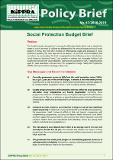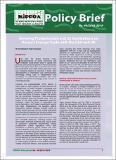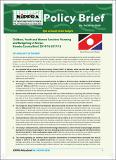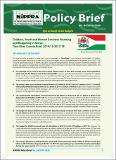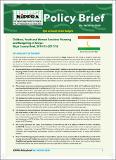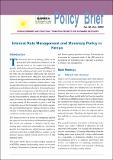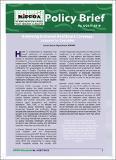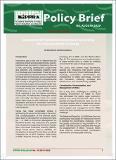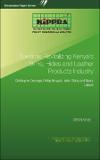Search
Now showing items 31-40 of 90
Policy Brief No. 67 of 2018-2019 on Social Protection Budget Brief
(The Kenya Institute for Public Policy Research and Analysis (KIPPRA), 2018)
This Social Protection budget brief is among five (5) budget briefs which seek to identify the extent to which the needs of children are addressed by the national budget and social sector budgets in Kenya. The brief offers ...
Policy Brief No. 49 of 2018-2019 on Growing Protectionism and its Implication on Kenya Foreign Trade with USA and UK
(The Kenya Institute for Public Policy Research and Analysis (KIPPRA), 2018)
Until after the global financial crisis, interdependence of world economies and increased cross-border trade in goods and services underpinned the growth of world economies. World trade grew faster than output by around ...
Policy Brief No. 54 of 2019-2020 on Children, Youth and Women Sensitive Planning and Budgeting in Kenya: Kiambu County Brief, 2014/15-2017/18
(The Kenya Institute for Public Policy Research and Analysis (KIPPRA), 2019)
This brief provides an analysis of how the County Government of Kiambu plans and budgets for the needs of children, youth and women. The analysis focused on social sector (health, education, water and sanitation, social ...
Policy Brief No. 84 of 2019-2020 on Children, Youth and Women Sensitive Planning and Budgeting in Kenya: Tana River County Brief, 201415-2017/18
(The Kenya Institute for Public Policy Research and Analysis (KIPPRA), 2019)
This brief provides an analysis on how the County Government of Tana River County budgets for the needs of children,
youth and women. The analysis focused on social sector budgets and actual expenditures for the period ...
Policy Brief No. 48 of 2019-2020 on Children, Youth and Women Sensitive Planning and Budgeting in Kenya: Wajir County Brief, 2014/15-2017/18
(The Kenya Institute for Public Policy Research and Analysis (KIPPRA), 2019)
This brief provides an analysis on how the County Government of Wajir budgets for the needs of children, youth and
women. The analysis focused on social sector budgets and actual expenditures for the period 2014/15-2017/18. ...
Policy Brief No. 10 of 2017-2018 on Delivering Affordable Housing in Kenya Requires a Paradigm Shift
(The Kenya Institute for Public Policy Research and Analysis, 2017)
The right to a decent housing by all Kenyans is a
constitutional obligation. The 2010 Constitution
of Kenya identifies access to adequate housing
and to reasonable standards of sanitation
as an economic and social ...
Policy Brief No. 06 of 2017-2018 on Achieving Universal Healthcare Coverage: Lessons to Consider
(The Kenya Institute for Public Policy Research and Analysis, 2017)
Health is fundamental to happiness and
overall well-being of households. A
healthy population translates to greater
strides in economic development since such
population is more productive, and saves and
invests more. ...
Policy Brief No. 05 of 2017-2018 on Promoting Public Participation for Improved Health Outcomes
(The Kenya Institute for Public Policy Research and Analysis (KIPPRA), 2017)
Public participation is key to improving and promoting health outcomes. Public participation can be defined as a way of communication whereby an institution or organization consults interested or affected individuals, ...
Policy Brief No. 92 of 2019-2020 on Assessment of Institutional Structure Governing the Informal Sector in Kenya
(The Kenya Institute for Public Policy Research and Analysis (KIPPRA), 2019)
Institutions play a key role in determining the economic growth and development of a country. Institutions are important in maintaining the rule of law, promoting development programmes and activities and protecting property ...
Discussion Paper No. 221 of 2019 on Towards Revitalizing Kenya's Skins, Hides and Leather Products Industry
(The Kenya Institute for Public Policy Research and Analysis (KIPPRA), 2019)
The leather industry is among the strategic industries that offer opportunity for Kenya’s economic transformation and sustainable development. The industry contributes about 1.9 and 4.0 per cent to GDP and Agricultural GDP ...

